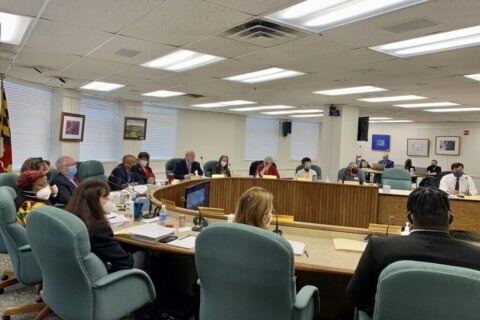This article was republished with permission from WTOP’s news partners at Maryland Matters. Sign up for Maryland Matters’ free email subscription today.
This content was republished with permission from WTOP’s news partners at Maryland Matters. Sign up for Maryland Matters’ free email subscription today.
Pennsylvania’s commitment of $220 million to a new fund dedicated to reducing pollution flowing into state waterways could prove “a remarkable turning point” in Chesapeake Bay cleanup efforts, a senior official with the U.S. Environmental Protection Agency said Thursday.
“We’re going to see a new trajectory now in the restoration of the bay,” said Adam Ortiz, EPA’s Mid-Atlantic regional administrator, during a press call about the creation of the new Clean Streams Fund and a new bill passed by the Pennsylvania legislature that sets standards for the use of fertilizer, a major source of pollution to waterways.
Pennsylvania state Sen. Scott Martin (R-Lancaster) said messaging that focused on clean water in the state rather than Bay cleanup had proved a “game changer” in convincing lawmakers to pass the fertilizer bill and dedicate $220 million in federal American Rescue Plan Act dollars to the new fund. Of that, $154 million is earmarked for a program that will provide cost-share assistance to farmers who agree to adopt certain conservation practices that will reduce pollution.
Maryland state Sen. Sarah Elfreth (D-Anne Arundel) called the funding “a watershed moment for Pennsylvania.”
“What happens upstream very much impacts our lives down here,” she said.
As the 2025 federal deadline approaches for cleanup of the Chesapeake Bay, the nation’s largest estuary, pressure on Pennsylvania has been growing.
Pennsylvania, Maryland and Virginia are the largest contributors of nitrogen, phosphorus and sediment pollution to the bay, where decades of excess nutrients and soil have led to widespread die-offs of plant and animal species. Pennsylvania alone is responsible for 43% of nitrogen flows into the bay, Virginia state Sen. Lynwood Lewis (D-Accomack) said Thursday.
The states have been working with the EPA to cut down on pollution flows since the 1980s, with varied success. Beginning in 2010, President Obama’s administration imposed a “pollution diet” on the Bay that required the six states (plus Washington, D.C.) that lie within the watershed to meet major reduction targets by 2025.
But while Virginia and Maryland have invested heavily in cleanup efforts and have largely met requirements imposed by EPA to date, Pennsylvania has stubbornly lagged behind.
In September 2020, Virginia, Maryland and Washington, D.C. sued the EPA, saying the agency under former President Trump’s administration failed to enforce Chesapeake Bay pollution reduction limits for both Pennsylvania and New York. EPA review had found that the states’ cleanup plans would still leave them millions of pounds short of their 2025 nitrogen reduction targets.
Ortiz, the former environment director for both Montgomery and Prince George’s counties in Maryland, said Thursday that he couldn’t speak about the ongoing litigation but is “optimistic” about its outcome.
The EPA has in recent months stepped up its enforcement of Pennsylvania. This April, Ortiz sent a letter to Pennsylvania Secretary of Environmental Protection Patrick McDonnell identifying continued shortfalls in the state’s cleanup plan and notifying him that EPA would be increasing inspection and enforcement actions.
“We wanted to hold the state more accountable,” he said Thursday, adding that inspectors have already discovered a number of long-term violations in the state.
Rick Ebert, president of the Pennsylvania Farm Bureau, said farmers are willing to adopt conservation practices to reduce pollution.
“We’re limited in our resources,” he cautioned. “Our margins are thin.”
Other states, including Virginia, have long operated cost-share programs to encourage farmers to embrace management strategies like streamside fencing and planting trees as buffers around waterways.
“We know in Virginia firsthand what these cost-share programs can do,” said Lewis. With money available, “thousands of farmers will come forward,” he added.
Martin acknowledged that the current $220 million allocation for the Clean Streams Fund is one-time funding.
The ARPA funds were a “great way to get out of the gate,” he said. “What we need to do is find the right mechanism that will give us sustainable funding going forward.”







